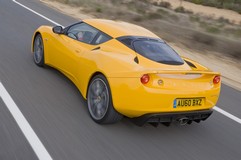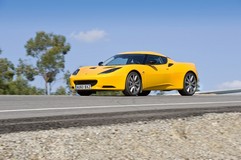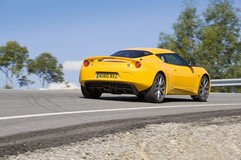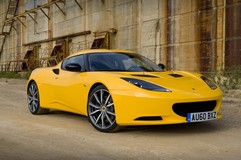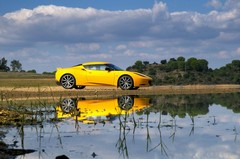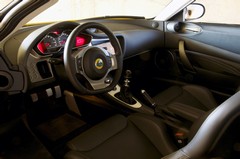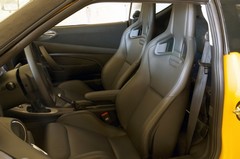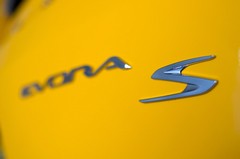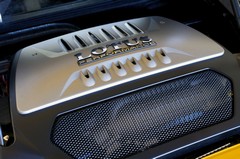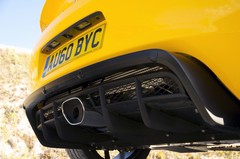Driven: Lotus Evora S
Hethel invokes the power of supercharging to 'man up' the Evora

And now we have a faster version, the obvious new feature being the fitment of a supercharger. It's a Harrop HTV 1320 with Eaton twin vortex technology that bolts onto the existing 2GR-FE 3.5-litre Toyota V6 without the need to touch the engine's internals. It swells the power of the Evora from 276bhp to 345bhp, and there's an increase of torque from 258lb to 295lb ft. The increased flexibility of the engine is made abundantly clear when you consider that the 'S' produces more torque at 2,500rpm than the standard Evora does at its torque peak.
The new engine has required twin oil coolers (mounted at the front) and considerable detail modification to the rest of the drivetrain. The six-speed gearbox has the closer, sports ratios (3rd, 4th, 5th and 6th are affected); while there's a new clutch, master cylinder, pedal box and new gearshift cables and linkage.
Getting straight to the point, the new engine has transformed the Evora. However good a car it was before, the experience has just moved up several notches on the excitement scale. The chief reason for this is the torque that's now available: even through a sequence of relatively tight corners you can leave the car in third gear, content in the knowledge that the car will pull strongly from 3,000rpm or lower when the need arises. The power keeps on building too, the car revving confidently out to the 7,200rpm limiter (when you're in 'Sport' mode), and by this point you'll be going very quickly indeed.
It'll hit 60mph from rest in 4.6sec (4.8sec to 62mph, a tenth quicker than a 911 Carrera and a good deal quicker than a Cayman S, even though at 1,437kg the Evora S is heavier than either of them) and go on top a top speed of 172mph (matching the Cayman S, but a little short of the 911's 180mph). The Nissan GTR though, of course, is significantly more potent still.
As engaging as the raw performance of the Evora S is, for me - and this is just a minor point - the Toyota V6 still doesn't have the crispness, the multi-layered vocal chords and smoothness of a dedicated performance engine from, for example, BMW or Porsche. Breathing through the optional sports exhaust it has at last found its voice, although you'll only hear the faint sounds of the supercharger at work with the window lowered, but it's a business-like gritty, growl rather than the sort of yelp that'd make your hairs stand on end - the sort that, say, you might get when enthusiastically exercising a Noble M12.
For the 'S', the gearbox has been improved and this can only be a good thing, but although much more 'together' in its operation it's still only a tool to do the job rather than a standout feature of the driving experience, and some care is needed at high revs/full throttle if you are to change gear cleanly.
Lotus has also taken this opportunity to take a second look at the chassis of the Evora, introducing a series of updates that may make it onto the regular car at a later date.
The front lower wishbone bushes and all of the rear suspension bushes are 10% stiffer, there're new front wishbones to increase castor angle, a slightly larger rear anti-roll bar and revised damping, but the spring rates stay the same.
The result is that, put simply, this car is divine to drive on a challenging road. It possess such purity of steering response and chassis communication that you never for a moment question it not doing exactly, emphatically what you've just asked it to do. No rival, German, Japanese or otherwise, can match the sheer tactility and precision that the Evora S offers, and few would be able to keep up with its subsequently stellar cross-country pace.
That it can do this, complete with circuit-suitable levels of strong-willed body control (we were able to drive it on a circuit and it had bags of enthusiasm, stamina and poise), and yet also ride bumps in the road with more comfort than some luxury cars is astounding. Sometimes you have to pinch yourself to remember this is focused sports car running (optional) 19" wheels on the front axle and 20" on the rear. It just makes you realise that big rims are not a worthy excuse for a poor riding car, and that the Evora S would make a fine long distance companion.
At £57,550 for the 2+0 (the 2+2 is £58,995) we drove (our car was over £62K with extras) the Evora S sits below the 911 Carrera (£65,889) and the Nissan GTR (£59,645, but £69,950 for the MY2011 model). Yes, there're some formidable rivals in this market niche, and the Evora S, while possessing a cabin of real flair and character, can't yet match the solidity, quality and ergonomics of interiors from the volume carmakers.
But anyone in the market for such a car as this who doesn't at least put the Evora S on their shopping list is doing to themselves a great disservice. Once driven, it's clear that it's a very, very special car indeed.
Gassing Station | General Gassing | Top of Page | What's New | My Stuff

